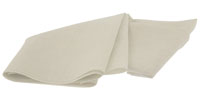| Nomex® has been used extensively in driver's suits and other racing safety gear. In fact, many people now use "Nomex" as a kind of shorthand that refers to all of their fire-retardant driver's gear. Unfortunately, this miracle of modern science is often misunderstood. |
What is Nomex?
Nomex® is a registered trademark from those chemical innovators at DuPont. The Nomex molecule belongs to a family of synthetics called aramids. Other aramid fibers include Kevlar® and Twaron®. Confusingly, the term "Nomex" can (correctly) refer to a number of different aramid blends based on Nomex fibers.
Our Part No. 2134-Color Nomex Cloth is technically Nomex® III, a cloth woven from a specific blend of fibers called Type 455. Type 455 Nomex has Kevlar mixed in for higher heat resistance. This makes it the most popular Nomex fabric for driver's suits.
What's so special about it?
Nomex has high tensile strength, yet it is soft enough to be woven into wearable textiles. Some types are even soft enough to be knit into very comfortable undergarments. Nomex will not melt or drip when exposed to flame. It provides very good insulation against heat in a fire. Nomex is also highly flame resistant.
Wait, don't you mean fireproof?
No. The suffix "-proof" means "will never happen" [citation needed]. "Fireproof" is impossible, just like "idiot-proof". You can make anything burn if you try hard enough.
Then what do you mean by "flame resistant"?
Flame resistant (or fire retardant, or self-extinguishing) means that it will not support combustion.
So you're saying that Nomex can catch fire?
No, and this is an important distinction. "Catching" fire means that the material will continue to burn on its own (supporting combustion) when you take away the flame. Fire retardant (etc) means that when you take the flame away, combustion stops on its own. The fire extinguishes itself.
For a race driver's suit, that means that once you get out of the fire, you're no longer on fire.
Hey, I just held my lighter to the end of some of your Nomex thread and I got a nice flame. What gives??
As we said before, anything will burn if you try hard enough. One of the best ways to get something to burn is to expose a flame to something with a high proportion of surface area to mass. This is why we light a piece of newspaper or kindling instead of holding a match straight to the big log on the campfire. It's also why grain elevators explode, and why you can burn steel wool with a match (and why 0000 grade burns the best). The frayed end of a piece of thread has a lot of surface area and very little mass.
The key is that the flame didn't keep travelling down the thread and set the rest of the spool on fire. The flame self-extinguished when you took the lighter away. Again, remove the Nomex from the fire and it stops burning.
So how do I know my Nomex suit won't burn?
The work has already been done for you. The FIA and SFI both have very stringent testing procedures with very specific grading criteria. The tests are carefully controlled so that the results can be reproduced reliably. This allows them to make direct comparisons of the actual performance of one fabric to another.
Like what?
To start with, they don't stick a loose thread in a random Zippo.
Ha, ha.
OK, seriously. A fabric sample of a specific size is held up to a specific type of flame (of a known temperature) in a specific position for a specific length of time.
Gee, could you be more "specific"?
It's all about making the test repeatable. They do it for the same reason that you wouldn't go barrelling into Corner 5 at a random speed, hit the brakes at a random point, apply a random amount of pressure using a random number of feet, and expect to set a lap record. Think of the sample size as the speed, the flame temperature as the brake marker, and the exposure time as the pressure on the pedal. Consistency is key to knowing what is really happening.
Fine, but what does that actually tell them?
When they take the flame away, they measure how long it takes for the sample to self-extinguish. They also measure how long it continues to glow after the flame goes out, how much surface area is charred, and any other damage. This allows a direct, apples-to-apples comparison of one fabric to another.
Similar tests are used by the FAA, NFPA, US military, and ASTM to evaluate a wide variety of different materials.
What is supposed to happen to Nomex in a fire?
When exposed to fire, the fibers carbonize and swell. Carbonizing absorbs some of the heat energy from the fire. The swelling closes off the pores between the fibers, which helps to block the hot air from moving through the fabric to the wearer. The swelling also thickens the fabric, increasing the amount of insulation.
Carbonized Nomex has a charred appearance, but it is still much stronger than fire-retardant treated cotton after exposure to the same temperature flame for the same length of time.
What is the maximum operating temperature for Nomex?
It depends on the desired lifespan of the fabric, and how much loss of strength is acceptable. Exposing Nomex to dry 580°F (304°C) air for 200 hours and then cooling to room temperature weakens the fibers by about 35%. Lowering that temperature to 500°F (260°C) extends the exposure period to 1000 hours with similar results.
Racing suits and firefighter turnout gear need to withstand much higher temperatures in a fire, but the expected exposure time will be (hopefully) much shorter.
For industrial (non-garment) applications, DuPont generally recommends observing a maximum operating temperature of 400°F (204°C).
Can I cover something with Nomex cloth to protect it from heat and flame?
Only for a short period of time. Nomex is an ideal fabric for protective garments when the wearer can be expected to get away from the heat source within a few minutes. The carbonization mentioned above is irreversible, which means that you can't line your fireplace with Nomex and expect to still have a Nomex liner when you come back the next day.
Silica-based insulating fabric retains its integrity much longer at high temperatures and is a better choice for most stationary applications. (But woven silica is not a good choice for garment fabrics, for a variety of reasons.)
Does Nomex expire? Is old Nomex any less fire retardant?
No. Fire retardance is an inherent property of Nomex, not a treatment or a coating. It will not fade away and can never wash out. BUT... that doesn't mean that a very old driver's suit is still a good choice!
Why not? If it was good enough for Mario in 1967...
First, there's mechanical wear. Abrasion, rips, pulled seams, stretched-out elastic, and worn-out Velcro can all compromise the integrity of a suit after a few years. Second, driver's suit design and construction have come a long way since then, both in terms of comfort and in terms of protection. A modern 3-layer suit can provide as much as five times the protection, while feeling infinitely cooler. That old vintage suit should be put on display in a protective frame.
You say your Nomex fabric is "6 ounce." What does that mean?
Ounces per square yard is one way to measure of the thickness of the cloth. One square yard of the fabric literally weighs 6 ounces. The metric equivalent would be 200 grams per square meter, or 200 GSM. A larger number means a thicker fabric. 6 ounce is a light-to-medium weave that could be found in a button-down shirt. For comparison, denim jeans are usually somewhere between 12 ounce and 16 ounce. (Note that there are a LOT of other factors that determine the look and feel of a material. Our 6 ounce Nomex cloth will not make a very good spread-collar Oxford.)
You say your Nomex thread is "Tex 60." What does that mean?
Tex is a measure of the thickness of the thread. It is the mass (in grams) of 1000 meters, in this case 60 g/km. It is the same as 540 denier (denier = grams per 9000 meters). A larger number indicates a thicker thread. Tex 60 is considered a heavy thread, recommended for quilting and sewing on repair patches. It is a good match for our 6 ounce Nomex cloth.
I heard that Nomex is dry-clean-only. Is that true?
No. Dry cleaning with perchloroethylene ("perc") is very effective at removing petroleum-based stains, but it is not necessary for routine care. Home laundering can be just fine as long as certain precautions are taken.
First, use laundry "detergent" and not laundry "soap". Soap does not rinse away as completely as detergent does. There is a remote chance that the soap residue will be able to burn, or at least block the Nomex from carbonizing in a fire. Fabric softeners should be avoided for the same reason. The Molecule Labs Nomex Care System is the best way we have found to clean and care for Nomex garments at home.
Second, take care to mate all hook-and-loop fasteners and zip up the zipper. Zipper teeth, and even those little Velcro hooks, can cause mechanical damage (abrasion and tearing) if you let them drag against the fabric. Cuffs and knit ventilation panels are especially vulnerable.
Third, wash your fire-retardant garments separately from your everyday clothes. Lint from regular garments could (theoretically) get caught in the Nomex with unpredictable results.
Finally, tumble dry on medium heat only. The high heat setting on some dryers is high enough to affect the strength of the fibers. Nomex does not retain moisture very well, so it will still dry quickly.
Buy Nomex Materials:
Nomex Fabric, Thread, and Hook-and-Loop Material
This article was first published on 5/18/2016.
It was most recently modified on 7/12/2017.


